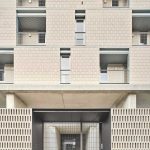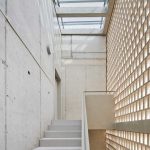54 viviendas sociales en Bon Pastor (Barcelona, España) por Peris+Toral Arquitectes. El Plan de Remodelación de Bon Pastor prevé el derribo de las 784 Casas Baratas del polígono construido en 1929 y su sustitución por bloques aislados para el realojamiento de todos los vecinos. La estructura urbanística de viviendas en planta baja y la proximidad de los vecinos favorecieron una forma de vida comunitaria que otorgaba al barrio la atmósfera de un pueblo dentro de la ciudad, con mucha vida en la calle.
El cambio de tipología de edificación, pactado con los vecinos, ofrece unas ventajas de la vivienda en altura, como las vistas privilegiadas al río Besòs, en detrimento de la vida comunitaria a ras de suelo donde las viviendas en planta baja se abren y se apropian de la calle.
Con el fin de recuperar y preservar parte de este modo de vida exterior se incorporan una serie de espacios intermedios entre el espacio público y las viviendas. En planta baja, se accede a través de unos patios comunitarios que anteceden a los vestíbulos. El cerramiento de celosía de la escalera exterioriza los recorridos verticales del edificio.
En planta piso, se disponen unas generosas terrazas, a modo de habitaciones exteriores, orientadas hacia el nuevo parque que linda con el frente fluvial. El aparcamiento discurre en una sola planta y consta de ventilación e iluminación natural ofreciendo un espacio adaptable en el tiempo a otros usos.
La vivienda pasante dispone el baño exento articulando la sala en dos espacios alrededor del núcleo y dobles circulaciones que permiten que la casa parezca más grande. Esta organización favorece la ventilación cruzada y la permeabilidad de la planta, tanto al aire como a la mirada, de manera que largas visuales atraviesan la casa de fachada a fachada.
Los bucles de circulaciones no solo se activan alrededor del baño sino también a través de las habitaciones mediante una terraza pasante que alarga el paseo por la casa, minimizando los espacios estancos y resiguiendo el contorno de la casa sin interrupción. El sistema de balcones metálicos volados incorpora persianas enrollables y actúa como soporte de vegetación.
En planta baja, las terrazas orientadas al parque se intercalan con los patios de ventilación del aparcamiento, generando un grosor a modo de filtro de intimidad entre el espacio público y la casa. El cerramiento de los patios orientados a la calle se desdobla para crear otra entrada de aire que permite la ventilación cruzada en el aparcamiento.
El uso de la obra vista, como materialidad determinada por el planeamiento, supone una oportunidad para introducir celosías que permiten dar una textura porosa a la fachada del edificio.
Ficha técnica
Nombre: 54 viviendas sociales en Bon Pastor
Ubicación: Bon Pastor, Barcelona, España
Arquitectos: PERIS+TORAL ARQUITECTES (Marta Peris, José Manuel Toral) + L3J TÈCNICS ASSOCIATS (Jaime Pastor)
Equipo P+T: Ana Espinosa, Guillem Pascual, Maria Megias, Izaskun González, Cristina Porta, Miguel Bernat
Ingenieria y Estructuras: L3J Tècnics Associats
Dirección de ejecución: Joan March i Raurell
Promotor: IMHAB. Instituto Municipal de la Vivienda de Barcelona
Presupuesto: 760 €/m2 PEM
Superficie: 8085 m2
Fecha: 2015- 2022
Fotografía: José Hevia
Contacto
https://peristoral.com/
English version
The Remodelling Plan for the neighbourhood of Bon Pastor anticipates the demolition of the 784 Casas Baratas (cheap houses) on the estate that was built in 1929, and their replacement by freestanding blocks to rehouse all of their occupants. The planning structure of single-storey houses and the closeness of the neighbours produced a form of community life that gave the district the atmosphere of a village within the city, with lots of life in the street.
The change in building typology, which was agreed on with the occupants, offers some advantages of high-rise living, such as prime views of the river Besòs, to the detriment of community life at ground level, where the single-storey dwellings open up and emerge into the street. In order to recover and preserve part of this outdoor way of life, a series of intermediate areas are incorporated between the public space and the dwellings.
At ground floor level, entrance is via communal courtyards that lead into the foyers. The lattice facing of the stairway externalizes the building’s vertical communications. On the first floor, generous terraces like outdoor rooms overlook the new park that borders the riverfront. The car park is laid out on a single level with natural ventilation and lighting, offering a space that can, in time, adapt to other uses.
The cross-ventilated dwelling has a free-standing bathroom, arranging the lounge in two spaces around this nucleus with two-way circulations that make the apartment seem bigger. This layout favours cross ventilation and opens up the floor plan to both air and views, with long lines of sight between the two façades.
These loops of circulation are created not just around the bathroom, but also through the bedrooms by means of a terrace that continues its route through the apartment, minimizing self-contained spaces and following the outline of the apartment without interruption. The cantilevered metal balcony system incorporates rolling shutters and provides a support for vegetation.
A park runs between the building and the river, filtering the sea air that circulates along the Besòs river corridor. The use of exposed brickwork, a material determined by planning, is an opportunity to introduce lattices that give the building’s façade a porous texture.
At ground floor level, the terraces overlooking the park are interspersed with the car park’s ventilation shafts, generating a thickness that forms a filter of privacy between public space and home. The facing of the courtyards on the street side doubles up to create another air inlet that allows cross ventilation in the car park.























